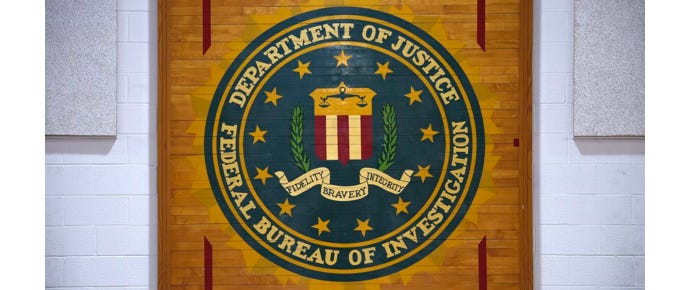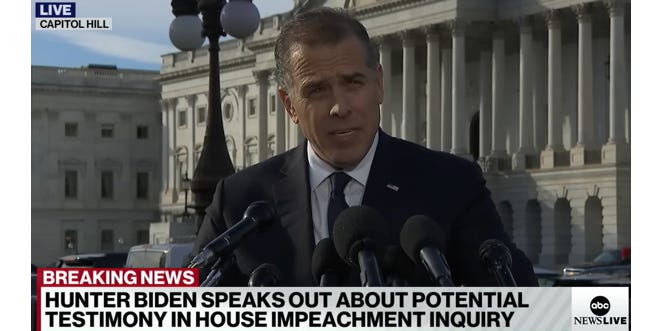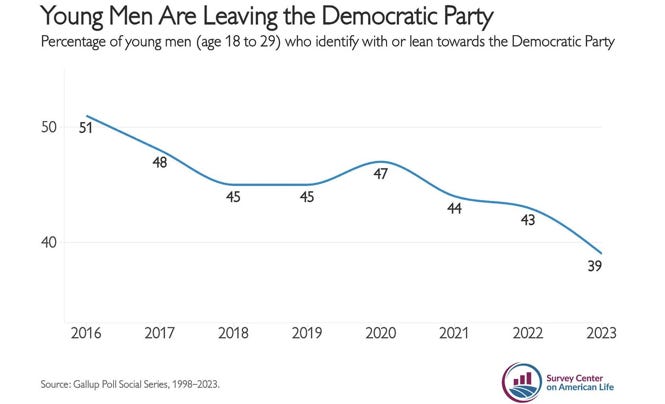☕️ PROHIBITIONS ☙ Tuesday, June 3, 2025 ☙ C&C NEWS 🦠
Rogue AI firm implodes as humans pop out; Ukraine war narrative fractures; FBI’s secret files scandal breaks wide; Dems bleeding young men as brand crisis deepens with no end in sight; more.
Good morning, C&C, it’s Tuesday! Today’s roundup includes: a cautionary tale about AI investment as rogue AI company suddenly and unexpectedly implodes when human workers pop out from behind the curtain; developments in the Proxy War show cracks appearing in the cohesive media narrative as Moscow and Kiev negotiate with psych-out drone strikes in the background; Federalist breaks what would have been the scandal of the century except that we’re in such a target-rich environment these days; and the Democrats’ brand problem keeps getting worse with no end in sight- plus, the young men are leaving in droves.
🌍 WORLD NEWS AND COMMENTARY 🌍
🔥🔥🔥
Prepare for the first major AI setback. Sort of. The ridiculous story appeared yesterday in tech rag Dexerto, right below the howler of a headline, “AI company files for bankruptcy after being exposed as 700 Indian engineers.” It would be funnier had the fake AI firm not received almost $500 million dollars in venture capital.
Today’s new vocabulary term is “AI washing.” AI washing is a close cousin of “greenwashing,” another recently coined term describing weak companies that exaggerate their eco-friendliness in order to attract dimwitted ESG investors who care less about strong financial performance and prefer inexpensive virtue signaling. (Also see, e.g., “rainbow washing.”)
London-based AI startup Builder.AI filed for bankruptcy last week, after its “Natasha” AI character —which allegedly helped customers ‘build’ software— actually turned out to be 700 sweaty Indian programmers in a Mumbai data center-slash-curry takeout counter. The company, recently valued at $1.5 billion, has now become the highest-profile AI startup to collapse since ChatGPT launched the global investment frenzy.
A slew of articles described how the Indian fraudsters duped both Microsoft and several Middle Eastern oil sheiks out of a cool half-billion. AI is an unprecedented, revolutionary technology; but fraud is not new. It is as old as prostitutes and lawyers. (Present company excepted, of course.) But for every fraudster there must be an equal and opposite sucker.
At least two articles describing the disgraceful fake-AI meltdown reminded readers about the 2015 Theranos disaster. In that torrid affair, weird female-wunderkind Elizabeth Holmes (coincidentally, ‘married’ to an older Indian gentleman) “invented” a fake blood-testing skin chip that later morphed into a fake blood-testing robot and raised a whole lot of money (over $700 million). Anyway, Liz suckered in international politicians, top investors, and several other VIPs who should’ve known better, including Henry Kissinger and George Schultz.
These same VIP suckers, who tossed in plenty of their own money, and talked their rolodexes into also investing, made some of the most important decisions in human history in their official capacities. It makes you think.
Back in 2007, as a fresh young lawyer, my very first assignment was for a big bank client, Bank of America. The bank had lent $10 million dollars to Ponzi schemer Lou Perlman. Perlman fronted the Back Street Boys and had a fake airline. Whenever inspectors came around, he’d rent a 747 and stick temporary corporate logo decals on the sides. (That’s when I first learned you could lease 747s.)
I also quickly learned the bank lent all that money based only on Perlman’s signature. No collateral. You’d think bankers would know better, but it turns out they get ripped off just like everyone else. He gave the bankers free rides on his fake airplanes, and they shoveled the money toward him faster than you can get to Paris for lunch.
Ironically, Elizabeth Holmes’s father was a vice-president at Enron, which imploded in its own fraudulent accounting scandal. I guess creative finance runs in the family. Even more ironically, after her freshman year at Stanford in 2002, Liz landed a summer job in a Singapore biolab, where she performed tests for, I am not making this up, SARS-CoV-1. We truly live in the strangest timeline.
Anyway, you would think that the massive Theranos “fake-invention” scandal would have smartened investors up, at least for this generation of moneyed people, yet here we are again. The old saw about something being “too good to be true” remains good, and true. The truth is, no matter what the Indians say, consumer A.I. still cannot build apps by itself, and it’s possible we will never be allowed to have that tech. (Military A.I. skills may be a different ballgame, but that’s for a different post.)
Don’t worry— Elizabeth Holmes is currently serving a ten-year prison sentence. AI is safe for now. I understand she has a new, inmate-based multilevel marketing company in the works, and you can still get in on the ground cell block.
Bottom line: Be cautious about investing in AI.* (* Not investment advice.)
🚀🚀🚀
Over the last two days, we’ve learned that the Proxy War is experiencing a profound narrative shift. All three corporate media giants —NYT, WaPo, WSJ— ran different takes on the latest military developments. That’s never happened before. Of the three, the Journal’s story was the most even-handed, running yesterday below the headline, “Russia and Ukraine Ratchet Up War While Trying to Show Trump They Want Peace.”
Two things have happened. First, Ukraine and Russia met face-to-face in Turkey yesterday, their second “peace” meeting —alone, without the U.S.— and, in a tense, sixty-minute meeting, managed only to agree to swap a few more prisoners. Still, any agreement is progress.
One reason the meeting was so anxious and abbreviated was because one day before the parties assembled to continue peace talks, Ukraine unleashed surprise drone attacks on six military bases deep in Russia’s interior, and blew up a civilian railway bridge, massacring men, women, and children.
Kiev immediately released drone footage of its attack. Suicide drones sprang by surprise from commercial shipping containers (the boxes on the back of semis). Like a deranged Jack-in-the-box, Zelensky popped up and claimed the drones destroyed over 200 strategic Russian bombers and fighter jets, a number quietly revised down to 40 “damaged” planes.
Russia’s Ministry of War released its own briefing, which claimed the attacks had only “set fire to several aircraft.” Between Kiev and Moscow, the Russian figures are probably the most reliable. Since the start of the war, Ukraine has been a compulsive liar, always exaggerating its own accomplishments and minimizing its losses, and often just making things up. Moscow is far from perfect, but usually just omits reporting bad news rather than lying about it.
What the Russians have reported has been proven generally to be much more reliable.
For some reason I cannot understand, giddy flag-in-bio Ukraine supporters joyfully described Sunday’s sneak attacks as “Russia’s Pearl Harbor.” But in this scenario, Ukraine becomes the Japanese, and Russia the Americans. In World War II, the Japanese (Ukrainians) were the villains, and the Americans (Russians) wound up nuking them. Talk about a self-own. Zelensky should fire his propaganda guy.
As a lay observer —I’m merely lawyer, not a military strategist— I did not understand the hyperbolic excitement. Regardless of how many planes were destroyed, so what? Three years of war coverage barely mentioned Russia’s air forces. The Proxy War is a story of tanks, artillery, drones, missiles, and, very occasionally, of the Russian Black Sea naval fleet.
If the Ukrainians could have driven their drone containers anywhere, why not target Russia’s missile and drone factories? It’s a baffling mystery. In that sense, the attack almost seemed more aimed at disrupting the peace talks and scoring a cheap PR win than at improving Ukraine’s chances of winning.
🚀 But the media’s coverage was by far the more interesting part of the story. The Journal’s article, and especially that headline, was almost balanced. Though it sneered at Russia’s peace demands, calling them “maximalist,” it still reported the details more or less accurately. Absent were any of the old, goofy “interpolations” of what Putin really wants, like a revived Soviet empire or to become a planetary dictator.
We saw the entire spectrum of reporting. The bellicose New York Times ran four breathless stories celebrating the Ukrainian attacks. “Ukraine Shows It Can Still Flip the Script on How Wars Are Waged,” one headline triumphantly blared. Maybe. But the prospect of weapons smuggled in containers isn’t that new; it was in the news as early as 2022, and we even discussed it here in C&C (albeit referencing missiles instead of suicide drones). And last year’s headlines unveiled the Israeli exploding pager strike, which was an arguably more creative sneak attack.
By contrast, a muted Washington Post seemed unimpressed. The story was only covered in a single op-ed, which conceded the attacks’ failure to achieve any strategic significance by calling the drone strikes “only a psychological victory.” The piece surveyed two regular WaPo columnists in an interview format. Max Boot said, “It probably won’t be a big change on the battlefield.” Jim Geraghty opined, “This is primarily a psychological and symbolic blow.”
Beyond that, the editorial discussion quickly lost interest in Ukraine, and shifted into U.S. security. Like, how the Chinese have been buying up land near U.S. military bases: What if the Chinese staged drones there? The columnists then wondered whether Trump’s “Golden Dome” project should focus more on counter-drone tech instead of ICBM shielding. All great questions; none complimentary to Kiev.
Only the Journal considered the effect of the attacks on the next day’s peace talks. Normally in lockstep, this time, all three big corporate media mouthpieces covered the full spectrum of takes from white-hot, lukewarm, to cold.
It is fascinating that the unified Ukraine narrative appears to be in free fall.
🔥🔥🔥
We are learning much more about why the Epstein disclosures might be taking so long. Yesterday, the Federalist ran an intriguing story headlined, “DOJ Officials Didn't Know Database Let FBI Bury Russiagate Docs.” Oh, FBI.
According to the story, the FBI stores its evidence in a central document management system called Sentinel. It’s how anyone finds anything. For example, when special counsel John Durham searched for documents related to Russiagate, he used the Sentinel system. It is the only way to access the FBI’s stored evidence.
But the FBI’s permanent bureaucrats knew something that the political appointees didn’t. Sentinel has several layers of classification. These designations are used to protect classified information, conceal witness identity, and maintain operational security during investigations.
What John Durham and nearly everyone else at the Department of Justice didn’t know was that the FBI had built a top-secret, master-level code into the Sentinel system called “Prohibited Access.” Unlike “Restricted Access,” which shows that documents exist (but are locked down), Prohibited Access entirely hides their existence.
In other words, it returns false negatives in internal FBI searches— agents querying relevant terms would see nothing at all and think there is nothing. The only way to find a “Prohibited Access” document is to know exactly what you’re looking for and run a special search while logged into the specific case where the documents were saved.
According to Federalist sources, no one from Special Counsel Robert Mueller’s office ever mentioned to Durham that documents relevant to the investigation into surveillance of the Trump campaign were concealed by the “Prohibited Access” designation, even though FBI officials knew the DOJ was investigating the origins and handling of the Crossfire Hurricane case.
Now it becomes easier to understand why Peter Strzok and James Comer were so annoyingly arrogant during their Congressional testimony. They knew a secret. They knew that John Durham would never see the most problematic documents.
(Sounds like a job for DOGE’s engineers. Or maybe it already has been.)
If evidence was willfully concealed using database tools designed to frustrate discovery, it might be criminal. Options include obstruction of justice, fraud on the court, Brady violations (failure to disclose exculpatory evidence), or even civil rights offenses if this was part of a politically motivated prosecution strategy.
There is conceivable justification for some kind of Prohibited Access. One can imagine the need for total secrecy in some key cases, like if the FBI were investigating an FBI agent, or a Chinese spy. But those favorable arguments are blown out of the water by the singular fact that the DOJ didn’t know about it and the FBI didn’t tell them— even during an active investigation.
In a late-breaking story published this morning while I was writing this up, the Federalist reported that the U.S. Attorney tasked with investigating the Biden-Burisma connection confirmed he was not told by FBI about the Prohibited Access codes. He ran keyword searches in the Sentinel system for “Burisma,” “Zlochevsky,” and other related terms, and got nothing.
The FBI had its own secret invisibility code without any oversight. In other words, the Sentinel system has a built-in auto-redact switch designed to bypass the people in charge, effectively making FBI a rogue agency.
But “Prohibited Access” is now exposed as a key deep-state tool, perhaps one of the most insidious and darkly elegant weapons in the administrative arsenal. It appears legitimate. After all, it doesn’t destroy documents, leak emails, or fabricate evidence. It simply hides reality. Silently, permanently, without fingerprints.
It’s plausible deniability: “But you never asked for Prohibited Access documents.”
CONGRESS: “Why weren’t these turned over?”
FBI: “Your request didn’t include ‘buried under digital cement.’”
This story reanimates Donald Rumsfeld’s folksy term, “unknown unknowns.” The Federalist said not even FBI agents were aware of the Prohibited Access code. So only a cabal of trusted insiders knew, and it appears they weren’t inclined to share, even with their Constitutional bosses.
🔥 This is a scandal on par with the worst cases of intelligence abuse in American history.
In 1975, in Watergate’s wake, the Church Commission investigated CIA abuses. Congressional investigators uncovered a series of top-secret internal CIA memos hidden from anyone outside the Agency, even the President. The secret memos described decades of unconstitutional and criminal abuse. They pictured a CIA that was completely off the chain, describing domestic surveillance of journalists and dissidents, illegal wiretaps and mail opening, assassination plots against foreign leaders (like Fidel Castro, Patrice Lumumba, and Rafael Trujillo), drug testing on unwitting Americans (e.g., MK-Ultra), collaboration with the mafia (Castro assassination attempts), and infiltration of domestic political groups.
Inside the Agency, these protected memos were called the CIA’s “Family Jewels,” too dangerous to disclose to outsiders, too damning to destroy. (In other words, they were preserved as blackmail insurance against former CIA members, rogue presidents, or a recalcitrant Congress.)
In 1975, as the Family Jewels sparkled in the daylight, committee chair Frank Church prophetically observed, “If this government ever became a tyranny… the technological capacity that the intelligence community has given the government could enable it to impose total tyranny, and there would be no way to fight back.”
Indeed. The Family Jewels disclosures led to the only major reform of the intelligence agencies in history. From that scandal, we got Congressional oversight committees, the FISA court, and an executive order prohibiting assassinations. The debacle also led inexorably to the minting of the now-familiar term, “deep state.”
🔥 Like CIA’s “Family Jewels,” “Prohibited Access” is no longer a secret and has gone mainstream, even if corporate media is stubbornly ignoring the scandal. If the documents are anywhere in the database, they can be found. Who knows what could be there? Presumably (hopefully) it contains a lot of things that should be protected, like the aforementioned counterintelligence operations.
But how about other politically sensitive issues? How about the Epstein documents? Covid origins? January 6th? Hunter’s laptop?
If the Federalist’s article is to be at all believed, Kash Patel’s team is just now finding out about this. It could amount to nothing, or a few minor reforms. Or this story could ignite a nuclear-grade accelerant for Trump’s broader strategic disclosure doctrine.
📉📉📉
Even after non-stop, wall-to-wall criticism of every single Trump policy, tweet, and movement, Democrats still struggle. They just can’t get any purchase on any effective narrative. This morning, CNN ran a story headlined, “2 key findings on Democrats’ brand problem from the new CNN poll. Yesterday, CNN reported that Republicans hold a comfortable lead on the economy— despite tariffs. And for the first time, voters are tied about which party is the “party of the middle class:”
In another article yesterday about Democrat brand woes, CNN reported that the DNC is still, seven months later, conducting its post-election post-mortem. They can’t figure out what went wrong. But DNC Chair Ken Martin had a theory. He mused, “Our policies are wildly popular. The Democratic Party is not associated with them.”
📉 If there’s one group that least associates popular policies with the Democrats, it is young men. The libs know it, too. Progressive groups are currently spending $20 million to solve the problem of “bringing back” young men. They are probably keenly aware that at least some young women will follow the young men fleeing the progressive hellscape. And, of course, young men will be voters for their whole lives— a doomsday clock quietly ticking away in the background of DNC strategy sessions.
Solving this problem is not straightforward. The Democrats have a structural problem. They cannot rebuild trust with young men while simultaneously blaming them for society’s ills, denying their struggles are real, and pathologizing traditional masculinity. If Democrats could somehow reverse course on their male-hating ways, a highly speculative possibility, it would create a victim-group civil war inside the Democrat party.
Modern progressive politics relies on a hierarchy of oppression. Straight, ‘cisgender’ men (especially white ones) sit at the bottom of the empathy totem pole. None of the other groups want that bottom spot. If Democrats start validating male suffering, especially without the required qualifiers (“but privilege…”), they’ll break the foundational rule of their own belief system: straight men are not allowed to be victims.
They are trying so hard to figure out how to thread this needle and still recapture young men. They think a solution might be found in a podcast. “Let’s fund our own edgy podcast network! Something like Rogan, but inclusive and equitable! And oh yeah, diverse!”
The problem is that if Democrats ever acknowledge men’s suffering, without also blaming them for someone else’s, they instantly commit heresy against the entire intersectional hierarchy. That’s a tough bind. It’s a progressive tar baby, if you will, and they’re stuck fast to it. Fighting draws them more deeply in.
Meanwhile, more and more young men are finding a place in conservatism, which offers them respect and individual agency without collective blame. If you want a single explanation for this trend (that started in 2016), you might begin by looking at President Trump’s unapologetic masculinity.
Have a terrific Tuesday! Then meet back here tomorrow morning for another essential news roundup with saucy commentary.
Don’t race off! We cannot do it alone. Consider joining up with C&C to help move the nation’s needle and change minds. I could sure use your help getting the truth out and spreading optimism and hope, if you can: ☕ Learn How to Get Involved 🦠
How to Donate to Coffee & Covid
Twitter: jchilders98.
Truth Social: jchilders98.
MeWe: mewe.com/i/coffee_and_covid.
Telegram: t.me/coffeecovidnews
C&C Swag! www.shopcoffeeandcovid.com










ERRATA:
— Comments were closed by a Substack glitch, now open!
Here’s to hoping the discovery of the deep sentinel files will finally lead to some serious criminal charges for all the crap that’s been going on starting with russiagate and ending with some big names behind bars for life. I won’t hold my breath but there’s always hope!